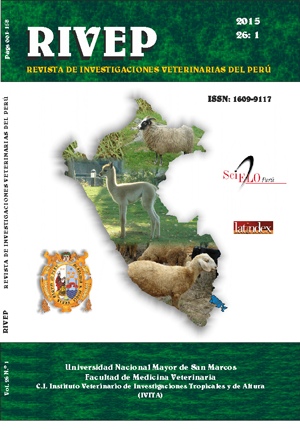Parasite community of cabinza grunt Isacia conceptionis (Cuvier & Valenciennes, 1830) (Perciformes: Haemulidae) in the area of Chorrillos, Lima, Peru
DOI:
https://doi.org/10.15381/rivep.v26i1.10943Keywords:
Choricotyle, Corynosoma, parasite ecology, IsaciaAbstract
The aim of this study was to evaluate the parasitic community of Cabinza grunt Isacia conceptionis (Cuvier y Valenciennes, 1830) (Haemulidae) (n=123) from the Fish Market of Chorrillos, Lima, Peru during December 2010 to March 2011. Parasites were fixed, preserved and quantitated by standard procedures. A total of 95 parasites of seven species were collected with an average abundance of 0.77. The average species richness was 0.46. The four most prevalent parasites and mean abundance were Choricotyle isaciencis Oliva, Gonzalez, Rus y Luque, 2009, Corynosoma obtuscens (Lincicome, 1943), Proleptus carvajali Fernández y Villalba, 1985, and Clavella simplex Castro y Baeza, 1985. Parasites ofI. conceptionis indicate that the three indices of aggregation [Dispersion (ID), Discrepancy of Poulin (D) and Negative Binomial (k)] mostly showed an aggregated distribution. The prevalence ofC. isaciencis correlated with the total length of the host fish. In relation to kn (relative condition factor), none of the fish parasitized byC. obtuscens, C. isaciencis, ectoparasites and endoparasites presented higher values compared with non-parasitized fish. The gonadosomatic index (GSI) was not associated with any of the indices of parasite ecology. Equity indices of parasitefauna showed relatively high values. Instead, dominance rates were low. Rates of interactivity (CC50) of ectoparasites and endoparasites indicated that communities were isolated.Downloads
Downloads
Published
Issue
Section
License
Copyright (c) 2015 José Iannacone, Lorena Alvariño, Jhon Chero, Gloria Sáez

This work is licensed under a Creative Commons Attribution-NonCommercial-ShareAlike 4.0 International License.
AUTHORS RETAIN THEIR RIGHTS:
a. Authors retain their trade mark rights and patent, and also on any process or procedure described in the article.
b. Authors retain their right to share, copy, distribute, perform and publicly communicate their article (eg, to place their article in an institutional repository or publish it in a book), with an acknowledgment of its initial publication in the Revista de Investigaciones Veterinarias del Perú (RIVEP).
c. Authors retain theirs right to make a subsequent publication of their work, to use the article or any part thereof (eg a compilation of his papers, lecture notes, thesis, or a book), always indicating the source of publication (the originator of the work, journal, volume, number and date).










